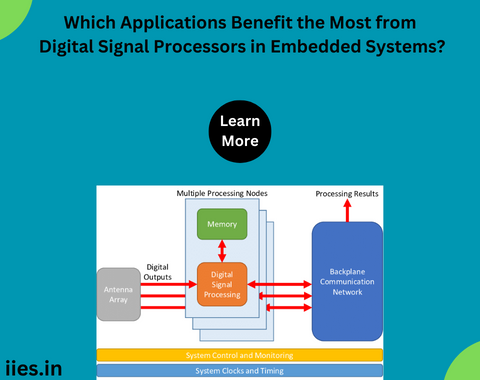
In the ever-evolving landscape of technology, embedded systems play a pivotal role in shaping the functionality and performance of numerous devices we encounter in our daily lives. Among the key components enhancing the capabilities of these embedded systems, Digital Signal Processors (DSPs) stand out as a transformative force. DSPs have proven to be indispensable in various applications, significantly improving signal processing efficiency. This article explores the applications that derive the most substantial advantages from the integration of DSPs into embedded systems.
One of the primary domains where DSPs excel is in communication systems. Whether it’s mobile phones, wireless networks, or satellite communication, DSPs play a crucial role in managing and enhancing the quality of transmitted signals.
Communication Systems:
They facilitate tasks such as modulation, demodulation, encoding, and decoding, ensuring seamless and reliable communication. The real-time processing capabilities of DSPs make them essential in maintaining signal integrity and optimizing data throughput.
Audio Processing:
Audio applications benefit immensely from DSPs embedded in systems. Devices like smartphones, music players, and home audio systems leverage DSPs for tasks like noise cancellation, equalization, and audio compression. Advanced DSP algorithms enhance sound quality, eliminate background noise, and deliver an immersive audio experience. In professional audio equipment, such as mixing consoles and audio processors, DSPs enable real-time audio signal manipulation and optimization.
Medical Imaging:
In the field of healthcare, embedded systems equipped with DSPs have revolutionized medical imaging. Ultrasound machines, magnetic resonance imaging (MRI), and computed tomography (CT) scanners rely on DSPs to process and reconstruct images with high precision. The ability of DSPs to handle complex mathematical operations in real-time is critical for obtaining accurate diagnostic images, contributing to advancements in medical diagnostics and treatment planning.
Radar and Sonar Systems:
DSPs play a vital role in radar and sonar applications, particularly in defense and maritime industries. Radar systems use DSPs for target detection, tracking, and signal processing to enhance situational awareness. Similarly, sonar systems employ DSPs to process underwater acoustic signals, enabling applications such as underwater navigation, fish finding, and submarine detection. The real-time processing capabilities of DSPs are paramount for accurate and timely information in these critical scenarios.
Automotive Systems:
The automotive industry has witnessed a significant shift towards incorporating DSPs in various embedded systems. In modern vehicles, DSPs are employed in advanced driver assistance systems (ADAS), audio processing for in-car entertainment, and engine control units (ECUs) for optimizing fuel efficiency and emissions. DSPs contribute to making vehicles safer, more efficient, and enjoyable for passengers.
Industrial Automation:
In the realm of industrial automation, DSPs play a crucial role in enhancing the efficiency and precision of control systems. They are utilized in processes such as motor control, robotics, and manufacturing automation. DSPs enable real-time monitoring and control of industrial processes, ensuring accuracy and responsiveness. The capability to process signals in parallel and execute complex algorithms makes DSPs invaluable in improving the overall performance of industrial systems.
Consumer Electronics:
From smart TVs to digital cameras, consumer electronics leverage DSPs to enhance user experiences. Image and video processing, speech recognition, and gesture control are some of the applications where DSPs contribute to the functionality and performance of devices. The efficiency of DSPs in handling multimedia data ensures smooth and responsive interactions in various consumer electronic products.
Internet of Things (IoT):
The Internet of Things (IoT) ecosystem relies heavily on embedded systems, and DSPs play a vital role in processing the vast amounts of data generated by interconnected devices. Whether it’s smart homes, industrial IoT, or wearable devices, DSPs contribute to real-time data processing, enabling quick and intelligent decision-making. In IoT applications, DSPs enhance the efficiency of sensor data processing, enabling devices to respond rapidly to changing conditions and ensuring seamless connectivity.
Aerospace and Defense:
In aerospace and defense applications, where precision and reliability are paramount, DSPs find extensive use. Avionics systems, navigation systems, and radar applications in aircraft and unmanned aerial vehicles (UAVs) leverage DSPs for real-time signal processing. These systems benefit from the ability of DSPs to handle complex algorithms and ensure accurate and timely responses in critical situations.
Biomedical Signal Processing:
Biomedical applications, such as electrocardiography (ECG), electroencephalography (EEG), and medical monitoring devices, rely on DSPs for processing and analyzing physiological signals. DSPs assist in extracting relevant information, filtering noise, and monitoring vital signs, contributing to advancements in healthcare technology. The real-time processing capabilities of DSPs are particularly crucial in medical scenarios where quick and accurate data interpretation is essential for patient care.
Robotics and Automation:
Robotics is another domain where DSPs play a pivotal role. Embedded systems equipped with DSPs enhance the precision and speed of robotic operations. From robotic arms in manufacturing to drones in agriculture, DSPs contribute to real-time decision-making and control. The ability to process sensory data and execute complex algorithms in milliseconds is indispensable for the advancement of robotic applications.
Energy Management Systems:
In the quest for energy efficiency, embedded systems with DSPs find application in energy management systems. These systems optimize energy consumption, monitor power quality, and control electrical loads in real-time. DSPs enable the implementation of sophisticated control algorithms, contributing to the development of smart grids and sustainable energy solutions.
In conclusion, the integration of Digital Signal Processors (DSPs) into embedded systems has proven to be a game-changer across diverse applications. The real-time processing capabilities, coupled with the ability to handle complex mathematical operations, make DSPs instrumental in improving efficiency, accuracy, and overall performance in embedded systems. As technology continues to advance, the role of DSPs is likely to expand further, contributing to innovations across various industries and shaping the future of embedded systems.
Indian Institute of Embedded Systems – IIES